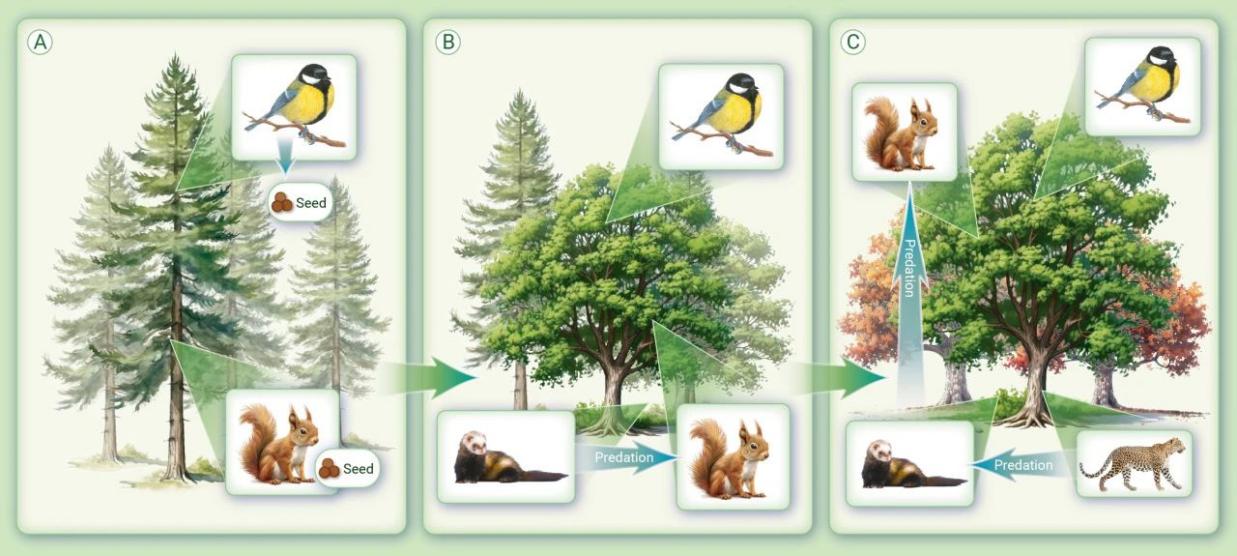China’s Artificial Forest Restoration Enters a New Phase that Integrates Animal Diversity Recovery
In recent years, media have frequently reported on the damage caused by wild boars to crops in China. This issue may be linked to the large area of artificial forests across the country which provides vast habitats for wildlife, contributing to an increase in populations of animals such as wild boars. However, the species diversity and structure of these forests are relatively simple, unable to support a broader range of wildlife, especially apex predators like tigers. Furthermore, artificial forests lack pollinators and seed dispersion limiting their succession into near-natural forest.
By 2022, China’s total forest area reached approximately 220 million hectares, with over 80 million hectares of artificial forests, accounting for 23.0% of the country’s land area. Over the past two decades, large-scale afforestation efforts have positioned China as the world leader in artificial forest expansion, contributing around one-quarter of the global increase in green cover. Since 1995, China has classified forests into ecological public welfare forests and commercial forests according to their purpose and management objectives. Currently China boasts 123 million hectares of ecological public welfare forests, with artificial forests making up 21.43% of the total.
While artificial forests in China have played a crucial role in ecological security, challenges remain. These include limited species diversity and simplified structure, predominance of middle-aged and young trees; a lack of shrub layers and ground vegetation; extensive use of non-native species; lower complex and stability compared to natural forests; and limited use of rare and endangered plants. China aims to double its GDP by 2035 from 2020 baseline. In line with this goal, substantial ecosystem services are needed to support social, economic, and ecological development. Given that the potential for improving natural forests is limited, the rewilding of artificial forests into near-natural forests assisted by human intervention is considered a promising strategy to enhance ecosystem services.
Researchers, including Dr. REN Hai from the South China Botanical Garden of the Chinese Academy of Sciences (SCBG, CAS), have suggested that the restoration of artificial forests into ecological public welfare forests should aim at maximizing the ecological, economic, and social benefits. The focus should be on enhancing ecosystem diversity, stability, and sustainability. This can be achieved by adjusting the species composition of artificial forests, replacing non-native species with native ones, and promoting rewilding through assisting seed dispersal, multilayered structures, and greater biodiversity.
During the transformation process from artificial to near-natural ecological public welfare forests, it is critical to shift from focusing on vegetation restoration to prioritizing the recovery of animal communities. This includes restoring the trophic levels of the forest ecosystem, ideally by reintroducing apex species. In the broader context of managing mountains, waters, forests, farmlands, lakes, grasslands, and deserts, restoration efforts should incorporate a systemic approach that emphasizes landscape-scale recovery, enhancing connectivity between ecosystems.
Nature-based restoration strategies are intended to enhance biodiversity and resilience against climate change meanwhile. To this end, there is a need for scientific innovation, including research on native and high-value plants, as well as holistic protection approaches that integrating situ conservation, ex situ conservation, and reintroduction programs. Additionally, strengthening the training of professionals in animal ecology and developing landscape-scale corridors are keys to the success of these initiatives.
The recovery of China’s artificial forests and apex species, will contribute to the achievement of the global biodiversity targets outlined in the Kunming-Montreal Global Biodiversity Framework, which calls for 30% of degraded ecosystems restored with high-quality standard by 2030. Given China’s vast range of artificial forests under various climatic conditions, this rewilding approach provides relevance for similar initiatives globally. This transformation represents a vital step toward fostering harmony between human and nature, contributing to the well-being of people worldwide.
This research has been published in The Innovation Life, a prominent multidisciplinary scientific journal. Dr. REN Hai from SCBG is the lead author of the paper. The link of this article: https://doi.org/10.59717/j.xinn-life.2024.100113

Figure. The plant and animal diversity of plantation forests gradually increases during the rewilding.(Image by REN et al)
File Download: